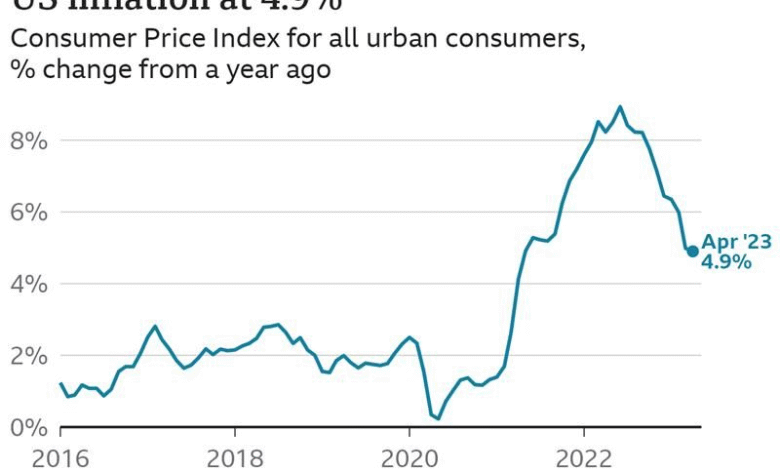April Inflation Rate Sees Unexpected Drop to 2.3%

The April inflation rate has emerged as a key focal point for economists and consumers alike, reaching 2.3%—the lowest annual rate since 2021. This figure reflects a modest rise in the consumer price index by 0.2% for the month, highlighting a subtle shift in economic conditions. Despite ongoing fluctuations, core CPI figures also mirrored this trend, showing a steady increase of 0.2% and a year-over-year benchmark of 2.8%. Factors such as the volatility of food prices and energy prices continue to play significant roles in the overall inflation narrative. Moreover, external influences like the Trump tariffs present a complex backdrop, potentially impacting future inflation trends as negotiations unfold in the coming months.
In recent discussions around economic stability, the topic of inflation has taken center stage, particularly with the recent findings for the month of April. The annual price increase rate, a critical indicator of economic health, settled at 2.3%, reaching its lowest level since early 2021. A closer look at the consumer price index reveals a similar uptick of 0.2% for the month, suggesting a nuanced economic environment. Core inflation metrics, unaffected by the volatility of food and energy sectors, are also significant, showing a consistent rise over the past year. Moreover, external economic policies, especially those linked to tariffs instituted during the Trump administration, are pivotal in shaping the inflation narrative as they influence consumer behavior and pricing dynamics across the market.
Understanding the April Inflation Rate of 2.3%
In April, the annual inflation rate settled at a modest 2.3%, marking a noteworthy decline that took many analysts by surprise. This figure is particularly significant as it is the lowest recorded inflation rate since February 2021, suggesting that prices are stabilizing after a period of heightened volatility. The consumer price index (CPI), which tracks the price movement of a wide spectrum of goods and services, rose by a mere 0.2% on a seasonally adjusted basis in April. This underwhelming rise reflects a cooling economic environment, giving consumers a brief respite from the soaring prices witnessed over the past few years.
The core CPI, excluding the often-volatile food and energy categories, also increased by 0.2% for the month, reflecting a year-on-year rate of 2.8%. This stability in core inflation indicates that, while essential goods remain pricier, the rate of increase is tempered compared to previous spikes. The overall inflation scenario demonstrates the delicate balance that policymakers must consider, as external factors like the continuing impact of Trump’s tariffs loom over the economic landscape.
The Impact of Consumer Price Index Movements
The movement of the consumer price index (CPI) is a crucial indicator of economic health, influencing everything from business planning to government policy. In April, the CPI increase of just 0.2% suggests a slow but steady adjustment in consumer prices, aligning with the overall inflation rate’s decline to 2.3%. This lower inflation rate signals to consumers that the sharp price increases seen in earlier years may be on the wane. However, the fact that the core CPI remains above 2% raises questions about the sustained affordability of everyday goods and services.
Furthermore, the detailed breakdown of CPI components reveals areas of concern. For instance, while energy prices saw a rebound of 0.7% after a decline in March, food prices remained a persistent worry, displaying only a 0.1% decrease. Significant fluctuations in specific categories, such as the noted drop in egg prices by 12.7%, highlight the volatility that can occur within the overall consumer price landscape. Ultimately, stakeholders must be cautious, as nominal changes in the CPI can mask underlying pressures and shifting consumer behavior.
Examining Core CPI and Its Implications
Core CPI, which strips out food and energy prices, stood at 2.8% year-over-year for April, indicating a relatively stable inflation environment. This metric is highly significant because it provides a clearer picture of long-term inflation trends. While the headline CPI shows an easing to 2.3%, the core figure indicates that there are persistent inflationary pressures in the economy. This distinction is essential for the Federal Reserve as it navigates monetary policy and considers potential interest rate adjustments.
Investors and policymakers closely monitor core CPI figures since they tend to reflect underlying inflation trends that can affect interest rates and economic growth. The slight bump of 0.2% in the core CPI aligns with market expectations, suggesting that while inflation is present, it is not escalating uncontrollably. As the Federal Reserve weighs its options, particularly against the backdrop of Trump’s tariffs and their potential impact on prices, understanding core inflation will be vital in formulating responsive economic strategies.
Impact of Trump Tariffs on Inflation Trends
The influence of Trump’s tariffs continues to be a wildcard in the inflation narrative. According to recent reports, the tariffs imposed on imports have started to show signs of affecting consumer prices, contributing to the overall inflationary landscape. As businesses facing higher costs shift some of these expenses onto consumers, the ramifications can ripple throughout the economy. In April, the CPI increase was modest, but the ongoing trade tensions hint at potential volatility in the months to come.
As negotiations continue over tariffs, particularly with China, the impact on specific commodities—like food and energy—remains uncertain. While current indicators show a stable CPI, the unpredictability of tariffs could mean that inflation could surge unexpectedly if negotiations do not progress favorably. This dynamic interplay between tariffs and inflation complicates forecasting and places pressure on the Federal Reserve to remain vigilant in its policy-making.
Food Prices and Their Role in Inflation
Food prices have consistently been a focal point in discussions about inflation, and the recent data from April reveals both challenges and trends. While the overall CPI rose modestly, the food segment reflected a decrease of 0.1%. This minimal decline came amid reports of specific commodity prices, such as eggs, which plummeted by 12.7%, prompting mixed reactions among consumers. Although food prices can exert significant influence on overall CPI readings, the current stabilization within this sector may provide some relief to households facing rising costs in other areas.
However, despite the drop in certain food items, the year-over-year dynamics reveal that consumers are still experiencing higher prices overall, with egg prices alone remaining nearly 49.3% higher than the previous year. Such stark variations prompt consumers to consider budgeting and spending habits closely, especially as essential food items shape overall living costs. Understanding how food prices fluctuate plays a critical role in assessing inflation trends and consumer confidence moving forward.
Energy Prices and Their Volatility
Energy prices are another critical component of the inflation equation, often subject to sharp fluctuations that can impact consumer spending. In April, energy prices rebounded with a notable increase of 0.7% after a significant decline in March. This rebound reflects the complex interplay between global energy markets, supply chain dynamics, and seasonal demand factors. The volatility seen in this sector can cause substantial ripple effects across the broader economy, influencing transportation, production costs, and ultimately consumer expenses.
The challenges posed by fluctuating energy prices underscore the importance of monitoring this sector as part of broader inflation trends. With the stabilizing CPI figures in April, a keen eye on energy costs becomes essential for predicting future inflation trajectory. If energy prices continue to rise, it could counteract the moderating trends seen in other sectors, complicating the Federal Reserve’s efforts to manage economic growth without provoking runaway inflation.
Market Reactions to Inflation Data
Market reactions to the published inflation data are often cautious, and April’s figures proved no exception. Following the release of the 2.3% annual inflation rate, stock futures remained flat, providing a signal that investors were digesting the mixed messages from the CPI report. With the inflation figures falling slightly below analysts’ expectations, the market’s muted response suggests a level of uncertainty regarding how these data points will ultimately influence the Federal Reserve’s decision-making process on interest rates.
In an environment where inflation has spent over four years above the Fed’s 2% target, market participants are keenly aware of the implications for monetary policy. The anticipation of interest rate cuts has shifted slightly, with traders reassessing timelines based on the recent inflation indicators. As economic conditions evolve, monitoring the markets’ response to inflation data becomes critical in understanding investor sentiment and future economic outlooks.
Federal Reserve’s Approach Towards Inflation Management
The Federal Reserve’s approach to managing inflation is intricate and multifaceted, particularly in light of April’s modest inflation figures. With the CPI reaching 2.3%, the Fed faces a balancing act between fostering economic growth and controlling inflation expectations. Policies surrounding interest rates will heavily depend on how consistently inflation performs relative to its targets. As the Fed evaluates whether to ease rates, it must also weigh the underlying economic data, including core CPI trends and external factors like tariffs.
In addition to current inflation rates, future decisions will hinge on broader economic indicators and the central bank’s assessment of market conditions. Given the sustained unpredictability of inflation stemming from global trade dynamics, including the Japan-China economic relationship and ongoing tariff negotiations, the Fed’s insights into inflation will remain critical. Policymakers must remain agile, ready to adapt strategies that maintain economic stability while keeping inflation at bay.
The Broader Economic Impact of Inflation
The broader economic impact of inflation, particularly in light of April’s figures, extends beyond consumer prices and influences various facets of economic activity. The reported inflation rate of 2.3% presents implications for wage growth, investment strategies, and consumer spending behaviors. As inflation rates stabilize, there’s potential for consumers to feel more confident in spending, given the favorable pricing of essential goods relative to earnings.
However, as prices for critical goods fluctuate, especially in food and energy sectors, wage growth needs to keep pace to ensure consumer purchasing power isn’t eroded. Economic growth driven by stable prices can encourage investments, while persistent inflation can stifle it. Thus, stakeholders across the financial spectrum must navigate the delicate balance between consumer confidence and inflationary pressures, guiding their strategies to meet changing economic realities.
Frequently Asked Questions
What was the April inflation rate for 2023?
The April inflation rate for 2023 reached 2.3%, marking the lowest annual rate since 2021.
How did the consumer price index change in April 2023?
In April 2023, the consumer price index rose by a seasonally adjusted 0.2%, contributing to an annual inflation rate of 2.3%.
What impact did food prices have on the April inflation rate?
In April 2023, food prices experienced a slight decrease of 0.1%, which influenced the calculation of the 2.3% inflation rate.
What role did Trump tariffs play in the April inflation scenario?
Trump tariffs remained a wildcard in the inflation landscape for April; their impact on the economy is contingent upon ongoing negotiations that could influence future pricing.
How did energy prices affect the April consumer price index?
Energy prices rebounded with a 0.7% increase in April, contributing to the overall changes in the consumer price index and the inflation rate of 2.3%.
What was the core CPI value for April 2023?
The core CPI for April 2023 also increased by 0.2%, with the year-over-year figure standing at 2.8%, slightly above the overall inflation rate.
Why is the April inflation rate considered lower than expected?
The April inflation rate of 2.3% was considered lower than expected due to slight increases in the consumer price index and the above-mentioned effects of Trump tariffs.
What does the April inflation rate say about the current economy?
The 2.3% April inflation rate indicates a cooling in inflation, as prices are significantly below the highs seen in previous years, suggesting a stabilizing economy.
How does the April inflation rate compare to previous months?
The April inflation rate of 2.3% is lower than previous months, reflecting a decrease in growth rates in both core CPI and overall inflation metrics.
Will the Fed respond to the April inflation rate?
The Federal Reserve may adjust its approach to monetary policy based on the April inflation rate of 2.3%, especially given its implications for interest rate expectations.
| Key Point | Details |
|---|---|
| Annual Inflation Rate | 2.3%, the lowest since February 2021 |
| Monthly Consumer Price Index (CPI) Change | Increased by 0.2% in April |
| Core CPI | Rose by 0.2%, with a year-over-year figure of 2.8% |
| Egg Prices | Dropped 12.7%, but up 49.3% from a year ago |
| Tariffs Impact | Trump tariffs continue to affect wages and pricing |
| Energy Prices | Increased by 0.7% after a decline in March |
| Shelter Prices | Increased by 0.3%, contributing over half of the inflation increase |
| Market Reactions | Markets remained flat with little to no significant reaction |
Summary
The April inflation rate stood at 2.3%, which is notably the lowest level recorded since February 2021. This unexpected decrease suggests a moderation in price increases, influenced by various economic factors, including recently imposed tariffs. Consumers observed a minor uptick in the overall consumer price index of 0.2% for the month, while core inflation measures maintained a steady trajectory. Egg prices, despite their overall decline this month, are still significantly higher compared to a year prior, highlighting the variability in food prices. The results indicate that while inflationary pressures persist, the landscape may shift as ongoing negotiations over tariffs play out, potentially impacting monetary policy decisions going forward.




